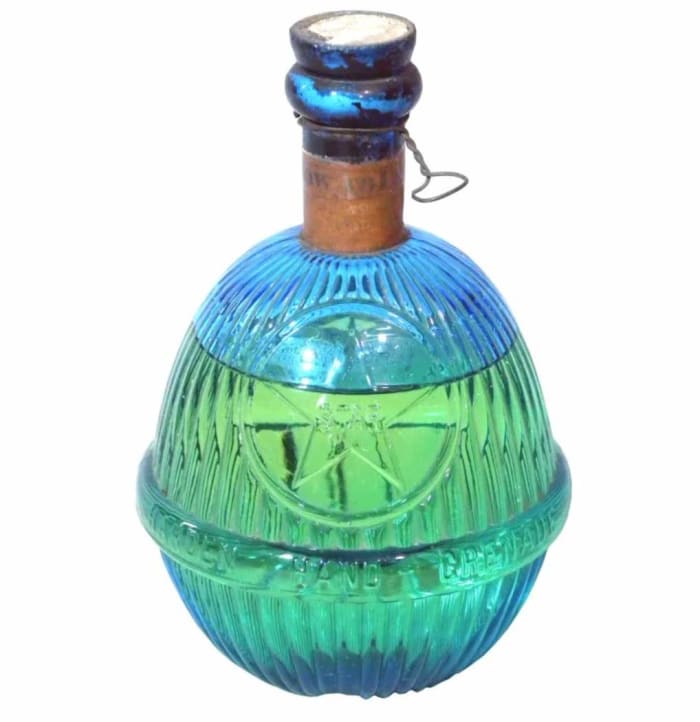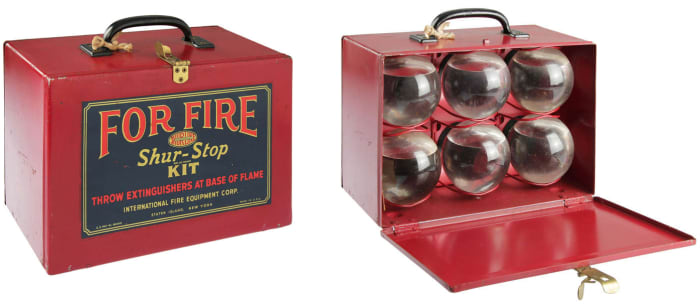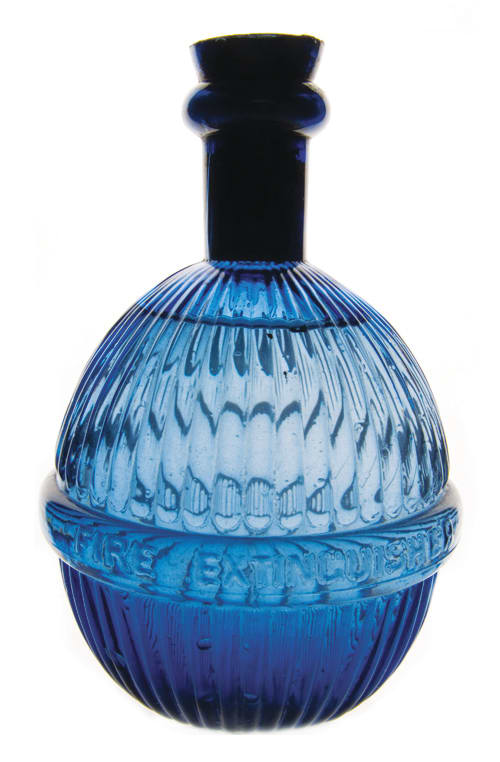During the 19th and into the first part of the 20th century nothing provoked a deadlier fear than fire. Cities from coast to coast suffered major fire calamities. San Francisco, Chicago, New York and Boston were each plagued with several large fires.
The earliest defenses were leather buckets, filled with water and transferred from hand-to-hand, with each then thrown onto the flames. These were followed by a wheeled apparatus, fitted with a hand operated pump, forcing water through a hose and onto a fire.
These were ways to combat fires in buildings, but what defense was available to the average citizens to defend themselves when a small fire broke out within the home. Within minutes, small fires leaped into roaring conflagrations.
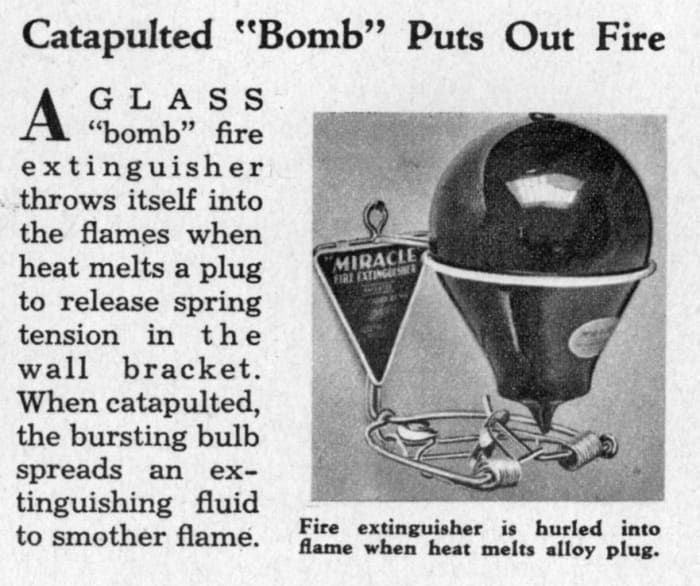
Article from August 1935 issue of Modern Mechanix; “Catapulted Bomb Puts Out Fire” heat from fire triggers spring catapulting the bulbous fire grenade into the fire. In 1935 this was an innovation for use in factories and commercial buildings. But one has to pause, if the heat from the flames can trigger the grenade the fire is probably already out of control.
Homes and buildings contained plenty of fodder to feed a fire, and several sources for ignition. Candles, kerosene and oil lamps, open fireplaces and wood and coal stoves were all triggers for combustion.
And as for the fodder, non-fire-retardant bedding and clothing, as well as combustible building materials, once ignited, would fuel a fire. Those waiting for the bucket brigade or the volunteer pumper force watched as buildings were engulfed in flames.
From the 1870s through the early 1900s, when a small fire broke out in the interior of the home, a glass orb known as a fire grenade was taken from a wall-mounted-bracket or kept handy next to the fireplace and thrown at the base of the flames. The grenades were filled, in some cases, with salt water (used because it would not freeze in the winter cold), others were filled with carbon tetrachloride and sealed with a cork and cement. The concept was simple; the glass orb shattered on contact and the contents, as it spewed onto the flames, vaporized into fire extinguishing gas.
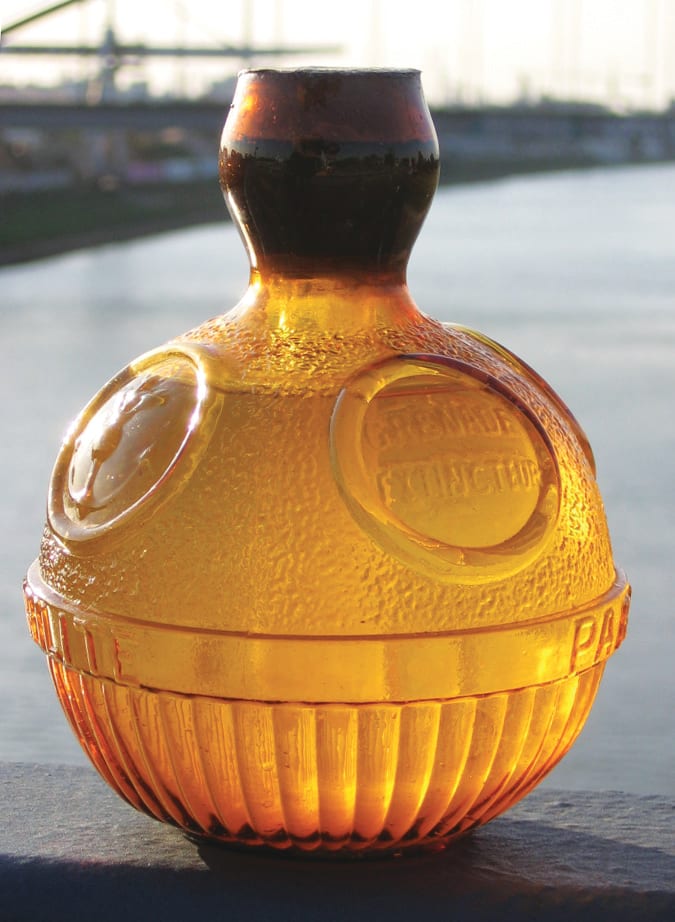
This 6” tall amber fire grenade was manufactured in France. It is sealed and still contains salt water inside.
Image courtesy of eBay
The First Fire Grenades
According to some historians, the fire grenade had its roots reaching back to time of the Roman Empire. Back then there were no bucket brigades or fire hoses. Some defense against fire was needed; buildings were equipped with primitive fire grenades.
The American Civil War was an incubator for new inventions and innovations, and it was during this time the idea of a fire grenade was resurrected. In 1863, the first patent for the fire grenade was awarded. (Several more patents would follow in later years.) In a burgeoning industrial nation such as America, when a market opened requiring goods or services, there was no shortage of manufacturers to provide them. Several companies exploded onto the scene to fill that niche.
The companies used powerful metaphors as a marketing tool. Red Comet was marketed as “the Original Automatic Fire Extinguisher.” The company based in Littleton, Colorado, cornered a large piece of the market with their trademark red orbs. ‘AutoFyrStop’ of Philadelphia touted their extinguishers as both automatic and ornamental. And with a name like ‘Shur-Stop’ how could their fire extinguisher grenade fail to do the job. But in several cases, they were ineffectual and did fail. They were helpful when a fire was just breaking out; beyond that stage, it was mostly a futile attempt to douse hungry flames.
[Related Article: American Fire Marks]
S.F. Hayward
S.F. Hayward, located on Broadway in New York City, found many customers among the city’s residents for their ‘Hand Fire Grenade.’ Harden’s Star Fire Grenade was one of the most popular brands. Fire grenades were made of thin glass, allowing it to shatter easily; some were plain glass orbs, while others were embossed with designs; bands, medallions and quilting gave a more ornamental look.
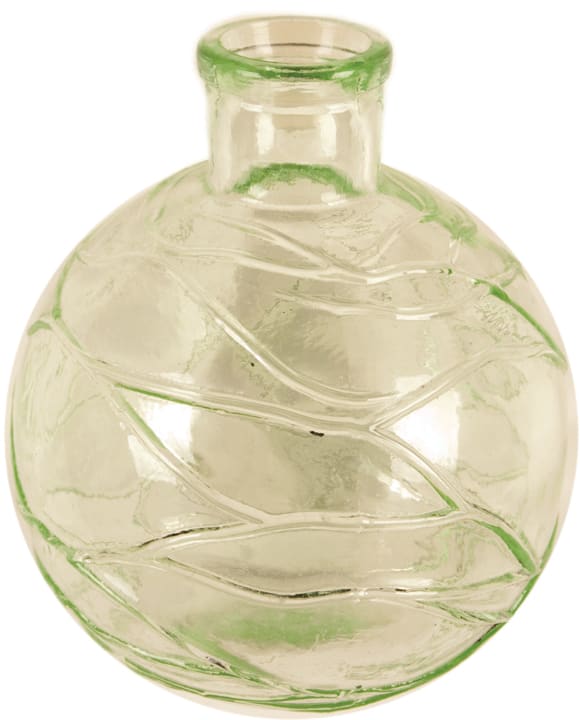
A smaller fire grenade example, stands just under 4”; has a fractured texture look, with shades of green running through it. Early American History Store lists this fire grenade for $295.
Image courtesy of Early American History Store
Some even resembled cut crystal—a perfect accessory for the Victorian mantle. A rainbow of colors was available; varying shades of aqua, amber and clear, others were green and cobalt blue; these last two colors are more highly sought after. A number of the grenades were only 4 inches tall, but as a rule, the grenades, including a narrow neck, were between 6 and 8 inches tall.
The Larkin Company
The Larkin Company produced fire grenades that were filled with an extinguishing powder, instead of liquid contents, which was released in a swinging motion over the flames.
The grenade manufacturers weren’t shy about claims attested to in their advertisements. Text highlighted the popularity and effectiveness of their products. Hayward’s made effective use of illustrations in their newspaper advertisements. In one such example, two young girls were confidently attacking a fire, in what appears to be the parlor of a Victorian era home, with the grenade extinguishers, although the blaze appeared out of control; the text below stating with the use of their grenade; “….fire cannot exist for a moment.” The price, $10 per dozen. Another popular illustration depicted a watchman, armed with a basket, similar to those used in carrying milk bottles, filled with fire grenades, attacking a fire he discovered while on his rounds. Production of fire grenades tapered off after 1905 with the advent of the modern brass and copper fire extinguishers.
The glass extinguishers were manufactured well into the 1950s. It wasn’t until 1954 that NFPA (National Fire Protection Association) stated in its Fire Protector Handbook that the “hand grenade fire extinguisher was no longer acceptable to the Underwriters Laboratory.” Aside from the dangers from broken glass, the carbon tetrachloride decomposed at high temperatures producing a toxic gas, Phosgene.
Collecting vintage fire grenades
Vintage fire grenades hold an attraction for many collectors. Those interested in collecting glass would enjoy these rather unusual fire extinguishers, for their variety of shapes and sizes; common shapes were bulbous, teardrop and round; they could also be in the form of a rolling pin. Collecting pieces from specific manufacturers holds great appeal; some of the rather ornate models address the interests of those fancying Victorian items. Their vivid colors and interesting shapes allow them to display well. And there are those engrossed in the broad spectrum of antique fire fighting items.
Although not found in as high numbers as other types of glass containers; many were destroyed in fighting home and factory fires, they can still be found at antique shops; and occasionally at flea markets and yard sales. Some have been discovered, while clearing out old factories, barns and garages. But a caveat; many of those that are sealed could still be filled with toxic liquid chemical contents. Examples might be found at a live auction; and most assuredly, they are offered on eBay. And don’t forget bottle shows. They are a great place not only to purchase fire grenades, but are also an excellent source of information on the subject.
Reproduction fire grenades
Reproductions, as with any collectible, can be a problem but there are things to look for. Those that are not authentic are, many times, made of thicker glass. Does it look too perfect? Maybe the lip is too smooth, or on some, the seam runs the entire length of the glass grenade, whereas the originals might have applied necks with the seam stopping at the shoulders of the piece.
Some reproductions are not intended to deceive and are sold as such. One example: Reproduction Harden’s Star Fire Grenade Extinguishers are marked with the letter “R” on the base. Of course, you always want to know who you are buying from.
Fire grenade values
Prices might start as low as $25 for a Red Comet and range higher to $2,000 and more for more rare examples. eBay seller skutz9741 was offering a AutoFyrStop fire grenade with original mounting bracket, frosted glass, complete with labels for an opening bid of $50. A mint S.F. Hayward Hand Fire Grenade that sits a bit over 6 inches was listed by eBay seller, tundra09. The piece is a deep amber color and has embossed diamond-shaped medallions on two sides; containing the message, “Patented August 8, 1871, 407 Broadway, New York.” eBay seller badge83 realized $102.50 for a beautiful aquamarine 8-inch-tall, Harden Fire Grenade Extinguisher with its trademark five-pointed star embossed within a large circle.
A number of the grenades were produced in France; a beautiful example was offered by German eBay seller, mallaubzustaub605. This 6-inch-tall amber model was manufactured in Paris and marketed under the brand of L’Incustomable and has four embossed circles. This particular extinguisher is still sealed with its original reservoir of salt water inside. On www.antiquebottletrader.com, two fire grenades were offered for sale. One is of French manufacture, light yellow amber in color, with four embossed circles on shoulders. The price is $275. The other is a mint dark cobalt blue made by Harden’s; almost 7 inches tall for $300.
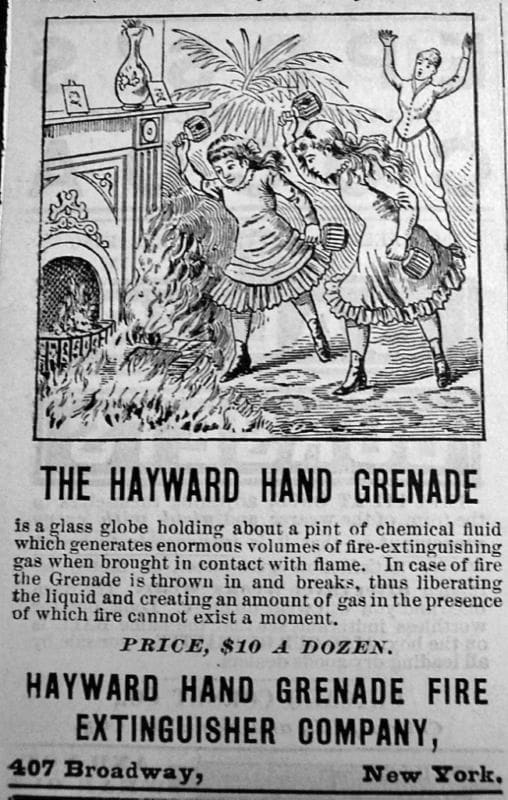
An advertisement from the 1880s touting Hayward’s Hand Fire Grenades for home use; driving home the point with illustration of two young girls attacking fire in the parlor with Hayward’s extinguishers.
Broadsides such as one from 1885, advertise the Hayward Hand Grenade Fire Extinguisher, for specific use in factories, hotels and other public buildings (they were even used on trains) average between $15 to $50; this particular sheet carries an illustration of a watchman discovering a fire while carrying a wire basket, filled with the glass extinguishers, on his rounds. He is depicted throwing a grenade onto the fire.
Fire grenade is a fitting name for this type of fire extinguisher; it was meant to be tossed just as one would lob a military grenade. The title of a 1985 article in the L.A. Times summed up the success of fire grenades; “Fire Grenade Wasn’t So Hot At Its Job.”
Learn more about fire grenades
For those wishing to learn more about fire grenades there are two publications that might be helpful; Digger O’Dell’s Fire Grenade and Target Ball 2011 Price Guide, and the Fire Grenade Price and Information Guide, by Albrecht and Feldhaus.
Sources


